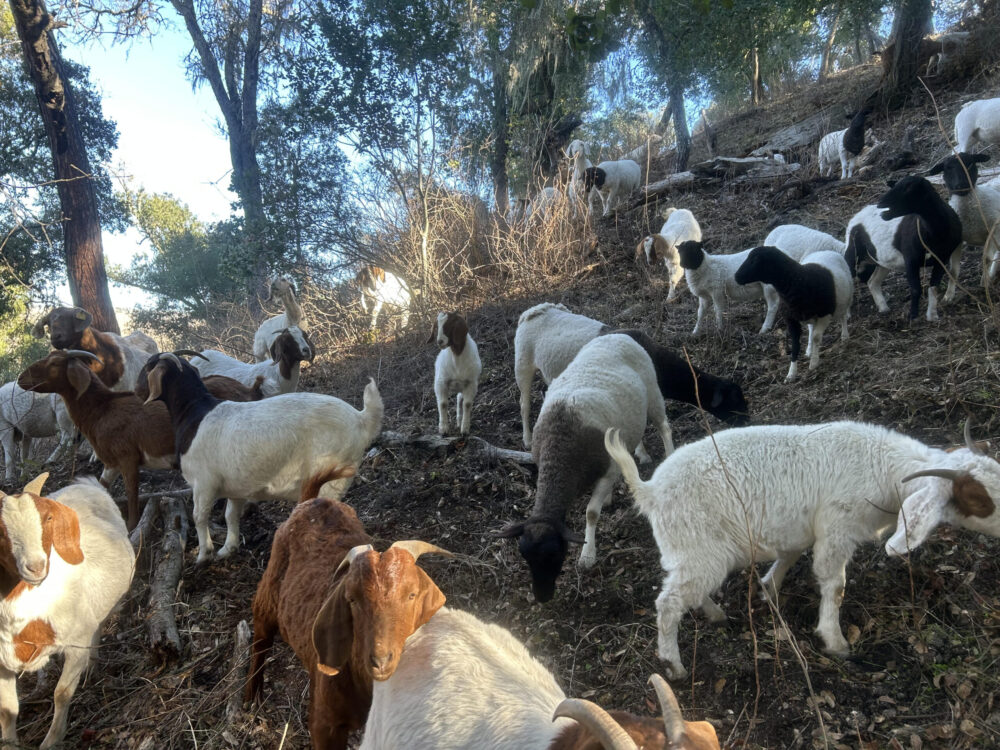
SLO Goats & Sheep clearing the land at the Atascadero Cemetery
What is Targeted Grazing?
Targeted grazing is a natural and eco-friendly land management method that utilizes goats and sheep to control vegetation. By strategically placing these animals in specific areas, they naturally graze on available plants, effectively reducing overgrowth. This process helps mitigate wildfire risks and enhances soil health without relying on machines or chemicals. Hardworking goats and sheep provide a sustainable and efficient solution for maintaining healthy landscapes.
Why is Grazing Beneficial?
Grazing works with nature to improve soil health. Goats and sheep aerate the soil with their hooves and spread natural fertilizer as they graze. Each adult animal leaves behind about four pounds of manure daily, enriching the soil with essential nutrients. Unlike cattle, which deposit manure in one spot, goats and sheep spread their waste more evenly, helping plants thrive. Even their urine acts as a natural fertilizer.
Well-managed grazing systems can be truly sustainable and improve soil health, help sequester carbon, and maintain plant biodiversity. The grazing animals are part of the cycle of life and the natural grass ecosystem. They are a natural part of the land. Temple Grandin (2022)
Properly managed livestock grazing can enhance wildlife habitat and contribute to carbon sequestration through soil health improvement. Here’s how:
- Carbon Sequestration:
- When plants are grazed (but not overgrazed), they allocate more energy to root growth, releasing carbon-rich root exudates into the soil.
- These exudates feed soil microbes, which help break down organic material and increase soil organic carbon levels.
- Healthy soils with high organic matter store more carbon, reducing atmospheric CO₂ levels.
- Wildlife Benefits:
- Grazing creates a mosaic of plant heights and densities, which benefits diverse wildlife species.
- It can maintain open habitats for grassland birds, improve forage quality for herbivores, and support pollinators by encouraging diverse plant species.
However, the effectiveness depends on grazing management—poorly managed grazing (overgrazing or mismanaged timing) can degrade soil and reduce carbon storage. But when done correctly, targeted grazing supports biodiversity and soil carbon sequestration.
Will Weeds and Brush Grow Back?
The year after grazing, weeds and brush won’t be as aggressive. For example, yellow starthistle seeds have only a 3% chance of surviving after passing through a goat’s digestive system (Goehring, 2009)! More sunlight reaches the ground, giving native plants a chance to grow and outcompete invasive species.
Goats eat weeds in a way that stops them from growing back. First, they eat the flowers so the plant can’t produce seeds. Then, they pick off the leaves one by one, leaving only the bare stem. Without flowers and leaves, the plant can’t photosynthesize, meaning it won’t grow new roots. Researchers Hooks and Joseph (2022) found that simply cutting weeds can make them grow back denser—but goats prevent this by consuming them completely.
Why Choose Targeted Grazing?
- Wildfire Prevention – Our goats and sheep remove dry brush and grass, creating natural firebreaks to slow or stop wildfires.
- Invasive Plant Control – They tackle poison oak, star thistle, mustard, and other invasive plants before they spread.
- Soil Health & Erosion Control – Grazing preserves soil structure and naturally fertilizes the land.
- Eco-Friendly Alternative – No herbicides, no emissions—just animals doing what they do best.
- Access to Hard-to-Reach Areas – Our herds navigate steep, rocky, and wooded areas where machines can’t go.
- Cost-Effective & Sustainable – Often cheaper than mowing, spraying, or manual removal—plus, it supports biodiversity.
Who Uses Targeted Grazing?
- Government Agencies & Fire Departments – Reduce fire hazards and manage public lands.
- Private Landowners & Ranchers – Keep pastures healthy and free of invasive plants.
- Vineyards, Orchards, & Farms – Control weeds naturally between vines and trees.
- Conservation Groups – Restore native habitats and promote biodiversity.
- Utility Companies – Clear vegetation under power lines to lower fire risks.
- HOAs & Communities – Maintain shared green spaces and fire-prone landscapes.
How SLO Goats & Sheep Can Help
We serve San Luis Obispo County with customized grazing solutions for California’s diverse landscapes.
- Customized Plans for Your Land
- We assess your property and create a grazing plan that fits your needs.
- Bringing in the Right Herd
- Goats eat thick brush, poison oak, and invasive plants.
- Sheep focus on grasses, making them perfect for firebreaks and pasture restoration.
- Our trained dogs and shepherds ensure the herd stays safe and on task.
- Eco-Friendly, Effective Grazing
- Our animals clear vegetation while naturally fertilizing the soil—no chemicals, no machines.
- We set up temporary, solar-powered electric fencing to focus grazing on specific areas, ensuring efficiency and safety.
- Long-Term Benefits for California Lands
- Reduces wildfire fuel, restores native plants, and improves soil health.